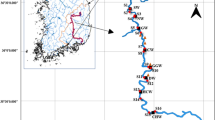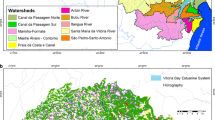Abstract
Green Lake, located in central Wisconsin USA within a watershed with land use dominated by agriculture, is listed as impaired under Sect. 303(d) of the Clean Water Act. The primary tributary, Silver Creek, is also impaired because of high total phosphorus (TP) concentrations. Silver Creek flows through a shallow marsh before reaching the lake. Prior to 2006, the marsh was turbid and free of macrophytes. Efforts to restrict carp (Cyprinus carpio) in the marsh and reduce the primary upstream phosphorus point source, resulted in the marsh becoming a clear-water, macrophyte-dominated system.
The point source reduction and marsh phytoplankton-to-macrophyte shift reduced the export of TP and suspended sediment (SS). These measured reductions at the marsh outlet exceeded the documented reductions in the upstream point source suggesting that the shift to a macrophyte-dominated system drove part of the TP reductions. TP loads at the marsh outlet significantly decreased in all seasons; however, SS loads significantly decreased in all seasons except winter, suggesting the vegetation shift was an important driver for these reductions. During 2012–2017, the marsh served as an overall sink for TP and SS, retaining on average 1.59 kg/day and 0.95 MT/day, respectively. Overall, this study documents benefits of a multi-stakeholder, collaborative ecological effort to restore a marsh from a turbid system to a macrophyte-dominated system, which resulted in significant reductions in downstream TP and SS loading to a major inland lake. This effort may serve as a model for similar restorations in other watersheds with land use dominated by agriculture.






Similar content being viewed by others
Data Availability
All flow and water quality data collected by the U.S. Geological Survey and used to compute daily loads are available from the National Water Information System (USGS, 2022), Robertson et al. (2022), or Robertson and Kennedy (2021). The datasets generated during and/or analyzed during the current study are available from the corresponding author on reasonable request.
References
Alisawi HA (2020) Performance of wastewater treatment during variable temperature. Appl Water Sci 10(89):1–6. https://doi.org/10.1007/s13201-020-1171-x
Bajer PG, Sorensen PW (2015) Effects of common carp on phosphorus concentrations, water clarity, and vegetation density: a whole system experiment in a thermally stratified lake. Hydrobiologia 746(1):303–311. doi: https://doi.org/10.1007/s10750-014-1937-y
Bajer P, Sullivan G, Sorensen P (2009) Effects of a rapidly increasing population of common carp on vegetative cover and waterfowl in a recently restored midwestern shallow lake. Hydrobiologia 632(1):235–245. doi: https://doi.org/10.1007/s10750-009-9844-3
Barko JW, Gunnison D, Carpenter SR (1991) Sediment interactions with submersed macrophyte growth and community dynamics. Aquat Bot 41(1–3):41–65. doi: https://doi.org/10.1016/0304-3770(91)90038-7
Butterfield B, Heath E, Hoyman T, Cibulka D (2015) Green Lake aquatic plant community assessment Green Lake County, Wisconsin. De Pere, WI. https://www.nelsonearthday.net/greenlake/docs/Green_Lake_Aquatic_Plant_Community_Assessment.pdf
Carpenter SR (1980) Enrichment of Lake Wingra, Wisconsin, by submersed macrophyte decay. Ecology 61(5):1145–1155
Fox J (2018) Package ‘car’. Available at: https://cran.r-project.org/web/packages/car/car.pdf
Fu L, Wang YG (2012) Statistical Tools for analyzing water quality data, Water Quality Monitoring and Assessment, pp. 143–168. Available at: https://www.intechopen.com/books/water-quality-monitoring-and-assessment/statistical-tools-for-analyzing-water-quality-data
Gao J, Xiong Z, Zhang W, Mba FO (2009) Phosphorus removal from water of eutrophic Lake Donghu by five submerged macrophytes. Desalin Elsevier B V 242(1–3):193–204. doi: https://doi.org/10.1016/j.desal.2008.04.006
Hector A, von Felten S, Schmid B (2010) Analysis of variance with unbalanced data: an update for ecology & evolution. J Anim Ecol 79(2):308–316. doi: https://doi.org/10.1111/j.1365-2656.2009.01634.x
Koltun GF, Eberle M, Gray JR, Glysson GD (2006) User’s Manual for the Graphical Constituent Loading Analysis System (GCLAS), U.S. Geological Survey Techniques and Methods, Book 4. Reston, Virginia, pp. 1–51, https://www.sciencebase.gov/catalog/item/4f4e4791e4b07f02db48b355
Lenth RV, Buerkner R, Herve M, Love J, Miguez F, Riebl H, Singmann H (2018) Package ‘emmeans’. Available at: https://cran.r-project.org/web/packages/emmeans/emmeans.pdf
Lougheed V, Crosbie B, Chow-fraser P (1998) Predictions on the effect of common carp (Cyprinus carpio) exclusion on water quality, zooplankton, andsubmergent macrophytes in a great lakes wetland. Can J Fish Aquat Sci 55(May):1189–1197. doi: https://doi.org/10.1139/cjfas-55-5-1189
National Oceanographic and Atmospheric Administration, National Centers for Environmental Protection (2022) Data Tools: Find a Station, accessed August 20, 2022, https://www.ncdc.noaa.gov/cdo-web/datatools/findstation
PRISM Climate Group (2022) Northwest Alliance for Computational Science and Engineering, PRISM Climate Data, accessed August 20, 2022, https://prism.oregonstate.edu
Robertson DM, Siebers BJ, Ladwig R, Hamilton DP, Reneau P, McDonald CP, Prellwitz S, Lathrop RC (2022) Response of Green Lake, Wisconsin, to changes in phosphorus loading, with special emphasis on near-surface total phosphorus concentrations and metalimnetic dissolved oxygen minima. U S Geological Survey Scientific Investigations Report 2022–5003:77. https://doi.org/10.3133/sir20225003
Robertson DM, Kennedy JL (2021) Eutrophication models to simulate changes in the water quality of Green Lake, Wisconsin in response to changes in phosphorus loading, with supporting water-quality data for the lake, its tributaries, and atmospheric deposition. U.S. Geological Survey data release. https://doi.org/10.5066/P9H85BK0
Schrage LJ, Downing JA (2004) Pathways of increased water clarity after fish removal from Ventura Marsh; a shallow, eutrophic wetland. Hydrobiologia 511:215–231. doi: https://doi.org/10.1023/B:HYDR.0000014065.82229.c2
Sesing M, Marks C, Kaiser J, Kavanaugh D, Johnson T, Eddy T, Mathias L, Tollard P, McCarty G, Hebbe J, Bartz D, Hoopman P(2015) A Lake Management Plan for Green Lake, Green Lake, Wisconsin. https://www.glakesd.com/wp-content/uploads/2014/08/Green-Lake-LMP-Part-1-UPDATED-2015.pdf
R Core Team (2020) R: A Language and Environment for Statistical Computing. Vienna, Austria: R Foundation for Statistical Computing. Available at: https://www.r-project.org/
U.S. Geological Survey (2022) USGS water data for the Nation: U.S. Geological Survey National Water Information System database, accessed August 20, 2022, at https://doi.org/10.5066/F7P55KJN
Weber MJ, Brown ML (2009) Effects of common carp on aquatic ecosystems 80 years after ‘Carp as a dominant’: ecological insights for fisheries management. Rev Fish Sci 17(4):524–537. doi: https://doi.org/10.1080/10641260903189243
Wisconsin Department of Natural Resources (2018) Impaired Water - Silver Creek (Silver Creek). Available at: https://dnr.wi.gov/water/impairedDetail.aspx?key=11028 (Accessed: 3 August 2018)
Funding
Funding was provided by the University of Wisconsin-Madison Nelson Institute for Environmental Studies. Any use of trade, firm, or product names is for descriptive purposes only and does not imply endorsement by the U.S. Government.
Author information
Authors and Affiliations
Contributions
Sarah Fuller: Conceptualization; Data curation; Formal analysis; Investigation; Methodology; Validation; Visualization; Writing - original draft; Writing - review & editing. Edward Boswell: Investigation; Visualization; Writing - review & editing. Anita Thompson: Conceptualization; Funding acquisition; Investigation; Methodology; Project administration; Resources; Writing - review & editing. Dale Robertson: Data curation; Formal analysis; Methodology; Visualization; Writing - review & editing.
Corresponding author
Ethics declarations
Competing Interests
The authors have no relevant financial or non-financial interests to disclose.
Additional information
Publisher’s Note
Springer Nature remains neutral with regard to jurisdictional claims in published maps and institutional affiliations.
Rights and permissions
Springer Nature or its licensor (e.g. a society or other partner) holds exclusive rights to this article under a publishing agreement with the author(s) or other rightsholder(s); author self-archiving of the accepted manuscript version of this article is solely governed by the terms of such publishing agreement and applicable law.
About this article
Cite this article
Fuller, S., Boswell, E.P., Thompson, A.M. et al. Water-Quality Improvement of an Agricultural Watershed Marsh After Macrophyte Establishment and Point-Source Reduction. Wetlands 42, 129 (2022). https://doi.org/10.1007/s13157-022-01649-0
Received:
Revised:
Accepted:
Published:
DOI: https://doi.org/10.1007/s13157-022-01649-0




